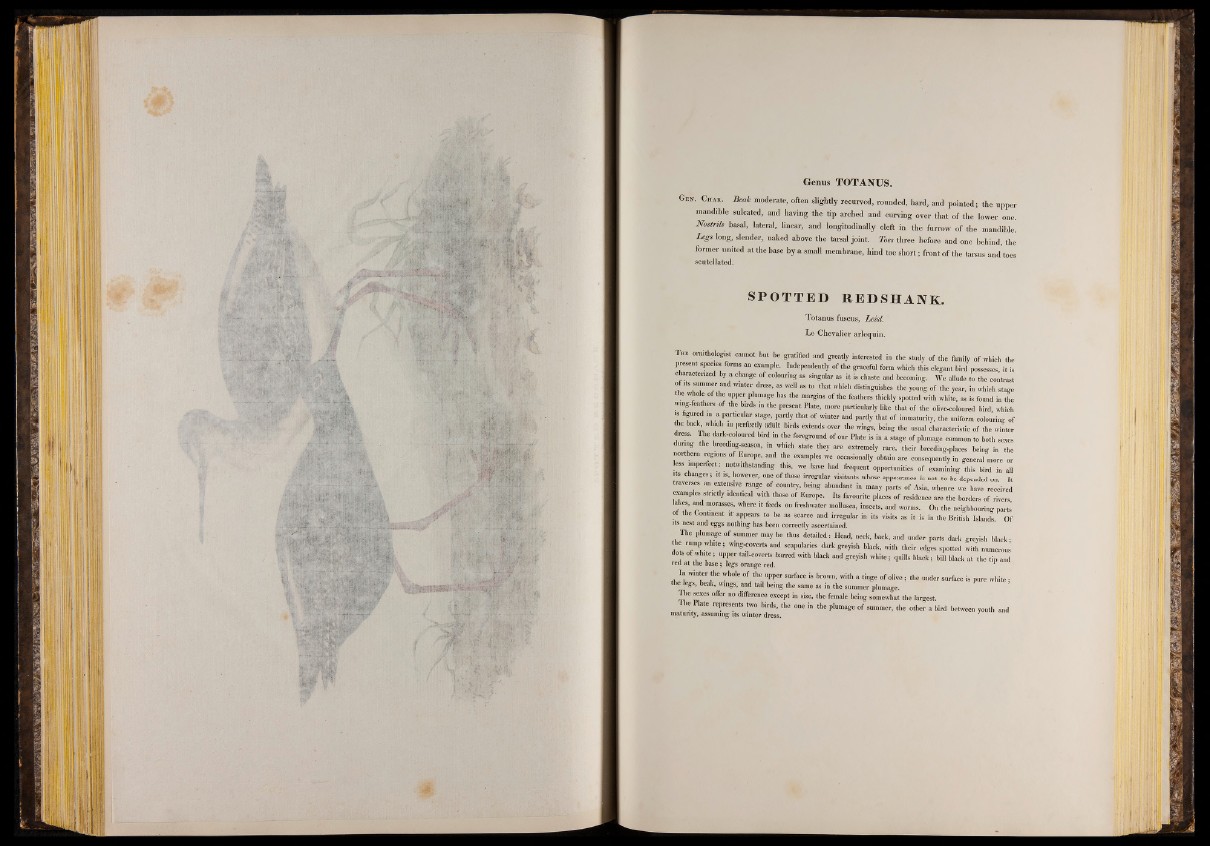
I
1
I
Ä S
f
> » « 3
i S ?
S t - ' i
vistfe#
w
Genus TOTANUS.
Gen. Char. Beak moderate, often slightly recurved, rounded, hard, and pointed; the upper
mandible sulcated, and having the tip arched and curving over that of the lower one.
Nostrils basal, lateral, linear, and longitudinally cleft in the furrow of the mandible.
Begs long, slender, naked above the tarsal joint. Toes three before and one behind, the
former united at the base by a small membrane, hind toe short; front o f the tarsus and toes
scutellated.
S POT T ED REDSHANK .
Totanus fuscus, Leisl.
Le Chevalier arlequin.
The ornithologist cannot bat be gratified and greatly interested in the study o f the family o f which the
present species forms an example. Independently o f the graceful form which this elegant bird possesses, it is
c aracterized by a change o f colouring as singular as it is chaste and becoming.. We allude to the contrast
o f its summer and winter dress, as well as to that which distinguishes the young o f the year, in which stage
the whole o f the. upper plumage has the margins o f the feathers thickly spotted with white, as is found in A e
wing-feathers o f the birds in the present Plate, more particularly like that o f the olive-coloured bird, which
is figured in a particular stage, partly that o f winter and partly that o f immaturity, the uniform colouring of
the back, which m perfectly adult birds extends over the wings, being the usual characteristic o f the winter
dress. The dark-coloured bird in the foreground o f our Plate is in a stage o f plumage common to both sexes
unng the breedmg-season, m which state they are extremely rare, their breeding-places being in the
northern regions o f Europe, and the examples we occasionally obtain are consequently in general more or
ess imperfect: notwithstanding this, we have had frequent opportunities o f examining this bird in all
its changes; it is, however, one o f those irregular visitants whose appearance is not to be depended on It
traverses an extensive range o f country, being abundant in many parts o f Asia, whence we have received
examples strictly identical with those o f Europe. Its favourite places o f residence are the borders o f rivers
H “ moraSSe8' whcre 11 feeds on freshwater mollusca, insects, and worms. On the neighbouring parte
o f the Continent it appears to be as scarce and irregular in its visits as it is in the British Islands. O f
its nest and eggs nothing has been correctly ascertained.
The plumage o f summer may be thus detailed : Head, neck, back, and under parts dark greyish black •
the rump white; wing-coverts and scapularies dark greyish black, with their edges spotted with n umeral
dots o f white; upper tail-coverts barred with black and greyish white; quills black; bill black at the tip and
red at the base; legs orange red.
in winter the whole o f the upper surface is brown, with a tinge o f o live; the under surface is pure white ;
the legs, beak, wings, and tail being the same as in the summer plumage.
The sexes offer no difference except in size, the female being somewhat the laigest.
The Plate represents two birds, the one in the plumage o f summer, the other a bird between youth and
maturity, assuming its winter dress.